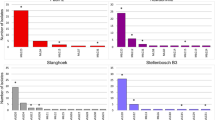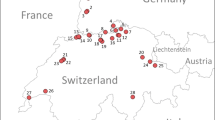Abstract
The genetic structure of a Plasmopara viticola population was characterized on five single vines, one for each cultivar Regent, Merlot, Isabella, Müller-Thurgau and Solaris, using four neutral specific polymorphic microsatellite markers. Five-hundred and seventy samples were collected at four dates in the period between the 10th of July and the 23rd of August 2006. On average over all five cultivars, 67% of the genotypes present on the single selected vines derived from primary infections and caused 37% of the lesions genotyped. Fifty-three percent of these genotypes occurred only once on the vine throughout the survey period, while 14% were able to asexually reproduce on the selected single vine throughout the survey period, causing 23% of the lesions. Thirty-three percent of the genotypes on the single vine derived from other vines, 28% from vines of other cultivars in the other rows, and 5% from vines of the same cultivar in the same row. New primary infections appear all along the sampling dates. The overwhelmingly quantitative role of primary infections at vineyard scale was known, however here we observed the phenomenon also at the single vine scale and the reduced contribution of secondary lesions to the populations present on more resistant cultivars compared to the susceptible cultivars. As the sampling extended almost to defoliation, the results are judged to be representative of a typical P. viticola epidemic.


Similar content being viewed by others
References
Aziz, A., Poinssot, B., Daire, X., Adrian, M., Bézier, A., Lambert, B., et al. (2003). Laminarin elicits defence responses in grapevine and induces protection against Botrytis cinerea and Plasmopara viticola. Molecular Plant-Microbe Interactions, 16, 1118–1128.
Bellin, D., Peressotti, E., Merdinoglu, D., Wiedemann-Merdinoglu, S., Adam-Blondon, A.-F., Cipriani, G., et al. (2009). Resistance to Plasmopara viticola in grapevine ‘Bianca’ is controlled by a major dominant gene causing localised necrosis at the infection site. Theoretical and Applied Genetics, 120(1), 163–176.
Beresford, R. M., Wood, P. N., Shaw, P. W., & Taylor, T. J. (2008). Application of fungicides during leaf fall to control apple scab (Venturia inaequalis) in the following season. New Zealand Plant Protection, 61, 59–64.
Boso, S., & Kassemeyer, H.-H. (2008). Different susceptibility of European grapevine cultivars for downy mildew. Vitis, 47(1), 39–49.
Calderon, A. A., Zapata, J. M., & Ros Barcelo, A. (1994). Peroxidase-mediated formation of resveratrol oxidation products during the hypersensitive-like reaction of grapevine cells to an elicitor from Trichoderma viride. Physiological and Molecular Plant Pathology, 44, 289–299.
Campbell, C. L., & Madden, L. V. (1990). Introduction to plant disease epidemiology. New York: Wiley.
Dai, G. H., Andary, C., Mondolot-Cosson, L., & Boubals, D. (1995a). Histochemical studies on the interaction between three species of grapevine, Vitis vinfera, V. rupestris and V. rotundifolia and the downy mildew fungus, Plasmopara viticola. Physiological and Molecular Plant Pathology, 46, 177–188.
Dai, G. H., Andary, C., Mondolot-Cosson, L., & Boubals, D. (1995b). Involvement of phenolic compounds in the resistance of grapevine callus to downy mildew (Plasmopara viticola). European Journal of Plant Pathology, 101, 541–547.
Díez-Navajas, A. M., Wiedemann-Merdinoglu, S., Greif, C., & Merdinoglu, D. (2008). Nonhost versus host resistance to the grapevine downy mildew, Plasmopara viticola, studied at the tissue level. Phytopathology, 98, 776–780.
Eugster, C. (2003). Relative contribution of oosporic and sporangial inoculum to epidemics of grapevine downy mildew and genetic structure of Plasmopara viticola in a New York vineyard assessed by microsatellite technique. Diploma Thesis, ETH-Zürich.
Ficke, A., Gadoury, D. M., Seem, R. C., Godfrey, D., & Dry, I. B. (2004). Host barriers and responses to Uncinula necator in developing grape berries. Phytpathology, 94, 438–445.
Gessler, C., Pertot, I., & Gobbin, D. (2006). Genetic structure and epidemiology of Plasmopara viticola populations. In I. Pertot, C. Gessler, D. Gadoury, W. Gubler, H.-H. Kassemeyer & P. Magarey (Eds.), Proceedings of the 5th International workshop on grapevine downy and powdery mildew (pp. 75–77).
Gindro, K., Pezet, R., & Viret, O. (2003). Histological study of the responses of two Vitis vinifera cultivars (resistant and susceptible) to Plasmopara viticola infections. Plant Physiology and Biochemistry, 41, 846–853.
Gobbin, D., Pertot, I., & Gessler, C. (2003a). Identification of microsatellite markers for Plasmopara viticola and establishment of high throughput method for SSR analysis. European Journal of Plant Pathology, 109, 153–164.
Gobbin, D., Pertot, I., & Gessler, C. (2003b). Genetic structure of a Plasmopara viticola population in an isolated Italian mountain vineyard. Journal of Phytopathology, 151, 636–646.
Gobbin, D., Jermini, M., & Gessler, C. (2003c). The genetic underpinning of the minimal fungicide strategy. Bulletin OILB/SROP, 26(8), 101–104.
Gobbin, D., Jermini, M., Loskill, B., Pertot, I., Raynal, M., & Gessler, C. (2005). Importance of secondary inoculum of Plasmopara viticola to epidemics of grapevine downy mildew. Plant Pathology, 54, 522–534.
Gobbin, D., Rumbou, A., Linde, C., & Gessler, C. (2006). Population genetic structure of Plasmopara viticola after 125 years of colonization in European vineyards. Molecular Plant Pathology, 6, 519–531.
Godard, S., Slacanin, I., Viret, O., & Gindro, K. (2009). Induction of defence mechanisms in grapevine leaves by emodin- and anthraquinone-rich plant extracts and their conferred resistance to downy mildew. Plant Physiology and Biochemistry, 47(9), 827–837.
Heintz, C., & Blaich, R. (1989). Structural characters of epidermal cell walls and resistance to powdery mildew of different grapevine cultivars. Vitis, 28, 153–160.
Holb, I., Heine, B., & Jeger, M. (2006). Effects of integrated control measures on earthworms, leaf litter and Venturia inaequalis infection in two European apple orchards. Agriculture, Ecosystems & Environment, 114(2–4), 287–295.
Horsfall, J. G., & Barratt, R. W. (1945). An improved grading system for measuring plant disease. Phytopathology, 35, 655.
Hug, F. (2005). Genetic structure and epidemiology of Plasmopara viticola populations from Australian grape growing regions. Diploma Thesis, ETH-Zürich.
Jermini, M., Blaise, P., & Gessler, C. (2003). Response of grapevine growth and yield quantity to the application of a minimal fungicide strategy for the control of the downy mildew (Plasmopara viticola). Bulletin OILB/SROP, 26(8), 25–29.
Jermini, M., Christen, D., Strasser, R., & Gessler, C. (2006). Impact of four years application of the minimal fungicide strategy for downy mildew control on the plant recovery capacities of Vitis vinifera cv Merlot. In I. Pertot, C. Gessler, D. Gadoury, W. Gubler, H.-H. Kassemeyer & P. Magarey (Eds.), Proceedings of the 5th International workshop on grapevine downy and powdery mildew (pp. 176–177).
Kast, W. K., Stark-Urnau, M., Seidel, M., & Gemmrich, A. R. (2000). Inter-isolate variation of virulence of Plasmopara viticola on resistant vine varieties. Mitteilungen Klosterneuburg Rebe und Wein, Obstbau und Früchteverwertung, 50(1), 38–42.
Kennelly, M. M., Gadoury, D. M., Wilcox, W. F., Magarey, P. A., & Seem, R. C. (2007). Primary infection, lesion productivity, and survival of sporangia in the grapevine downy mildew pathogen, Plasmopara viticola. Phytopathology, 97, 512–522.
Koopman, T., Linde, C. C., Fourie, P. H., & McLeod, A. (2007). A Population genetic structure of Plasmopara viticola in the Western Cape Province of South Africa. Molecular Plant Pathology, 8(6), 723–736.
Kortekamp, A. (2006). Expression analysis of defence-related genes in grapevine leaves after inoculation with a host and a non-host pathogen. Plant Physiology and Biochemistry, 44, 58–67.
Kortekamp, A., & Zyprian, E. (1999). Leaf hairs as a basic protective barrier against downy mildew of grape. Journal of Phytopathology, 147, 453–459.
Kortekamp, A., & Zyprian, E. (2003). Characterization of Plasmopara-resistance in grapevine using in vitro plants. Journal of Plant Physiology, 160, 1393–1400.
Kortekamp, A., Wind, R., & Zyprian, E. (1998). Investigation of the interaction of Plasmopara viticola with susceptible and resistant grapevine cultivars. Journal of Plant Diseases and Protection, 105, 475–488.
Kortekamp, A., Wind, R., & Zyprian, E. (1999). The role of hairs on the wettability of grapevine (Vitis spp.) leaves. Vitis, 38, 101–105.
MacHardy, W. E., Gadoury, D. M., & Gessler, C. (2001). Parasitic and biological fitness of Venturia inaequalis: relationship to disease management strategies. Plant Disease, 85(10), 1036–1051.
Pezet, R., Gindro, K., Viret, O., & Spring, J.-L. (2004). Glycosylation and oxidative dimerization of resveratrol are respectively associated to sensitivity and resistance of grapevine cultivars to downy mildew. Physiological and Molecular Plant Pathology, 65, 297–303.
Richter, H., Pezet, R., Viret, O., & Gindro, K. (2006). Characterization of 3 new partial stilbene synthase genes out of over 20 expressed in Vitis vinifera during the interaction with Plasmopara viticola. Physiological and Molecular Plant Pathology, 67, 248–260.
Rumbou, A., & Gessler, C. (2004). Genetic dissection of Plasmopara viticola population from a Greek vineyard in two consecutive years. European Journal of Plant Pathology, 4, 379–392.
Rumbou, A., & Gessler, C. (2006). Particular structure of Plasmopara viticola populations evolved under Greek island conditions. Phytopathology, 96, 501–509.
VIVC, Vitis International Variety Catalogue. (2007). IRZ, Institut für Rebenzüchtung Geilweilerhof.
Wong, F. P., Burr, H. N., & Wilcox, W. F. (2001). Heterothallism in Plasmopara viticola. Plant Pathology, 50, 427–432.
Acknowledgements
This work was supported by SBF 03.0485-1 (EU-Project 501542 REPCO). The authors gratefully acknowledge Rocchina Abbas-Pennella for helping with the laboratory work, Michele Gusberti and Natasha Rosselli for helping with the collection of samples and disease assessment, and Roberto Rigoni and Mirto Ferretti for the maintenance work in the vineyard.
Author information
Authors and Affiliations
Corresponding author
Rights and permissions
About this article
Cite this article
Matasci, C.L., Jermini, M., Gobbin, D. et al. Microsatellite based population structure of Plasmopara viticola at single vine scale. Eur J Plant Pathol 127, 501–508 (2010). https://doi.org/10.1007/s10658-010-9615-z
Accepted:
Published:
Issue Date:
DOI: https://doi.org/10.1007/s10658-010-9615-z




